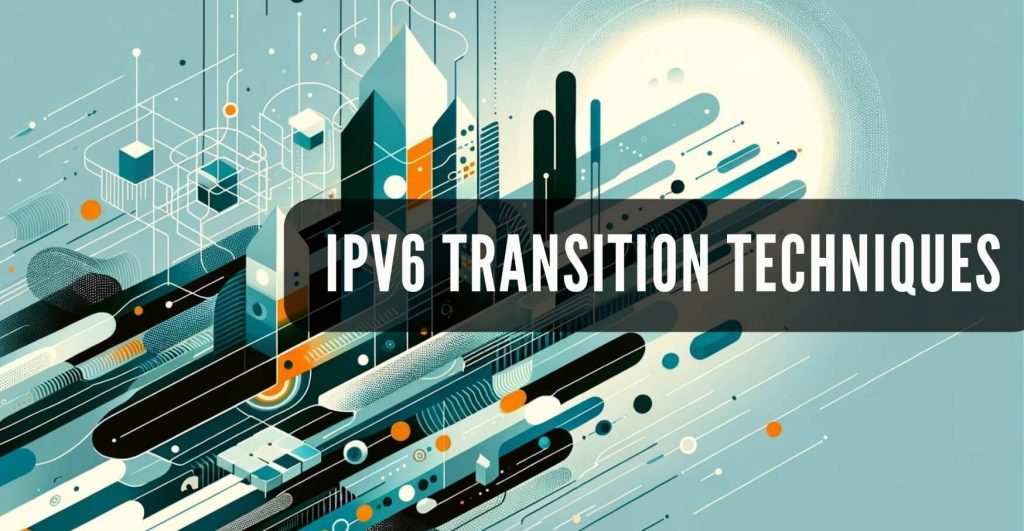By now, it is likely that everyone has heard of the significant transition from IPv4 to IPv6, which is occurring globally. But how exactly is this change implemented? There are three primary methods to facilitate the migration to IPv6: Dual Stack, Tunneling, and Translation. Each approach has its advantages and disadvantages, so let’s examine them in more detail.

Table of Contents
1. Dual Stack
The Dual Stack method facilitates the coexistence of IPv6 and IPv4 (IPv6 vs IPv4) within a shared network infrastructure. This technique empowers network devices to simultaneously utilize both IPv4 and IPv6 addresses. It helps with seamless communication across both protocols. This transition method finds particular relevance during the transitional phase from IPv4 to IPv6 adoption, providing a smooth and efficient migration path.
To start implementing a Dual-Stack Network:
- Activate Dual-Stack Mode: Configure network equipment to operate in dual-stack mode, enabling both IPv6 and IPv4 communications.
- Ensure Compatibility: Maintain IPv4 support, as many internet-connected devices are still IPv4-dependent.
- Monitor Network Performance: Regularly assess the network for any performance issues during the dual-stack operation.
Dual Stack Pros and Cons.
| Aspect | Pros | Cons |
| Flexibility | Supports both IPv4 and IPv6 protocols | – |
| Transition | Allows gradual migration to IPv6 | Temporary solution, not long-term |
| Compatibility | Ensures connectivity across different networks | – |
| Resource Usage | – | Requires more memory and processing power |
| Configuration | – | Increases complexity in network management |
| Longevity | – | Seen as an interim measure |
2. Tunneling
In IPv6 deployment, the Tunneling approach involves encapsulating IPv6 packets within IPv4 packets. As the name implies, this method enables IPv6 hosts to communicate using the existing IPv4 infrastructure (like a tunnel). It serves as a valuable transition mechanism in scenarios where direct IPv6 connectivity is unavailable. Common tunneling methods such as 6to4 and Teredo tunneling facilitate the connection of IPv6 islands through an IPv4 network.
To start using IPv6 Tunneling:
- Set Up Encrypted Tunnels: Establish encrypted tunnels for transporting IPv6 packets across IPv4 networks.
- Support Legacy Devices: Use tunneling to connect devices that lack IPv6 capability.
- Plan for Gradual Migration: Implement tunneling as a transitional step while upgrading to IPv6-compatible equipment.
Tunneling Pros and Cons.
| Aspect | Pros | Cons |
| Compatibility | Enables IPv6 traffic over IPv4 infrastructure | Requires additional processing for encapsulation |
| Transition | Facilitates gradual transition to IPv6 | Can introduce latency and overhead |
| Infrastructure Cost | Avoids the immediate need for IPv6 infrastructure upgrade | Tunnel endpoints require proper configuration |
| Connectivity | Allows isolated IPv6 networks to communicate globally | Dependence on IPv4 can impede IPv6 adoption |
| Network Performance | – | Potential for reduced performance due to tunneling |
| Ease of Implementation | Useful for temporary connectivity solutions | Not a permanent solution; complexity in long-term management |
3. Translation
Within the context of IPv6 deployment, the Translation approach, represented by Network Address Translation-Protocol Translation (NAT-PT), entails the conversion of packet headers between IPv4 and IPv6 formats. This conversion enables communication between networks that exclusively utilize either IPv4 or IPv6, effectively enhancing interoperability between diverse IP protocol versions.
To start using IPv6 Translation:
- Set Up NAT-PT: Install and configure devices or services that support NAT-PT for translating IPv4 and IPv6 packet headers.
- Define Translation Rules: Establish rules within the NAT-PT system for how packet headers are to be converted between IPv4 and IPv6.
- Integrate into Network: Integrate the NAT-PT system into your existing network infrastructure to enable communication between IPv4-only and IPv6-only segments.
Translation Pros and Cons.
| Aspect | Pros | Cons |
| Compatibility | Enables direct communication between IPv4 and IPv6 | May introduce issues with certain protocols and applications |
| Transition | Facilitates phased adoption of IPv6 | Not a long-term solution; seen as a temporary measure |
| Infrastructure Cost | Reduces immediate need for full infrastructure overhaul | Can be complex to manage and configure |
| Network Performance | – | Can cause delays and efficiency losses due to translation |
| Scalability | Supports existing IPv4 devices | Scalability issues due to NAT state maintenance |
| Security | – | Potential security challenges with address translation |
Translation vs Proxying? While a proxying shares some similarities with translation, as both involve intermediary devices, they are still different methods. Proxying is the process of mediating communication between clients and servers, which most of the time, handle requests and responses on behalf of the clients. In addition, proxying typically operates at a higher level of the OSI model, focusing on application-layer protocols such as HTTP, rather than packet-level translation. This process (although similar to translation) offers its own unique set of benefits and considerations for IPv6 transition.
Final Words.
An official post from APNIC, discusses The IPv6 transition mechanisms and protocols that help connect IPv4 devices over IPv6 networks. It mentions various IETF standardized technologies like DS-Lite, Lightweight 4over6, MAP-T, MAP-E, 464XLAT, DNS64, and NAT64 (a mix of dual-stack, tunneling and translation mechanisms).
Each of these IPv6 transition mechanisms has its distinct advantages and features, as well as certain limitations, which were discussed briefly in this post. The IPv6 migration techniques vary in latency, throughput, and packet loss. Which transition mechanism to choose? The final choice should be based on different and various parameters like network size, device availability, cost, and security concerns.
Additionally, (and most importantly) organizations have the option to build an IPv6 network (native IPv6) from scratch during a network hardware refresh cycle, eliminating the need for dual stacks, tunnels, and translation methodologies. Ready for a seamless IPv6 transition?
Discover RapidSeedbox’s IPv4 and IPv6 rental services at RapidSeedbox.
Benefit from:
Unparalleled 24/7 customer support.
Direct IP ownership, no brokers.
Flexible deployment; RapidSeedbox servers or yours.
0Comments